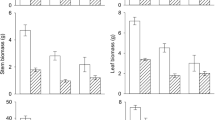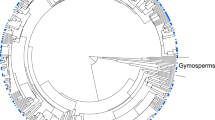Abstract
Allelopathy, plant–plant interactions mediated through chemical production, is an active area of ecological research. Despite this widespread interest, we still lack community scale information on the prevalence of this interaction and the types of species that may be expected to be allelopathic. To address this research need, the allelopathic potential of 65 plant species from all stages of succession in the Piedmont region of New Jersey, USA, was determined with laboratory bioassays. The strength of each species’ allelopathic activity was then related to life form, origin, and fundamental plant traits. The vast majority of species tested exhibited significant allelopathic effects in the bioassays, with many of these having fairly strong effects. Overall, the allelopathic potential of species decreased with life span, roughly following the successional transitions from short-lived to long-lived herbs and to woody species. Herbaceous species on average were more allelopathic than woody species, but there was no difference between native and non-native species once life form was accounted for. In a principal components analysis, allelopathy was associated with other plant traits, but these relationships differed between woody and herbaceous species. Allelopathic potential was positively associated with plant height in herbaceous species, but negatively associated with height, leaf mass, and seed mass in woody species. These results indicate that allelopathy may be a quite common ecological strategy in plants and is equally common in both native and non-native species. The linkage of allelopathy with other plant functional traits suggests that allelopathy can and should be integrated into the broader suite of plant strategies that are studied.





Similar content being viewed by others
References
Abhilasha D, Quintana N, Vivanco J, Joshi J (2008) Do allelopathic compounds in invasive Solidago canadensis s.l. restrain the native European flora? J Ecol 96:993–1001
Bazzaz FA (1975) Plant species diversity in old-field successional ecosystems in southern Illinois. Ecology 56:485–488
Bertholdsson NO (2011) Use of multivariate statistics to separate allelopathic and competitive factors influencing weed suppression ability in winter wheat. Weed Res 51:273–283
Buell MF, Buell HF, Small JA, Siccama TG (1971) Invasion of trees in secondary succession on the New Jersey Piedmont. Bull Torrey Bot Club 98:67–74
Butcko VM, Jensen RJ (2002) Evidence of tissue-specific allelopathic activity in Euthamia graminifolia and Solidago canadensis (Asteraceae). Am Midl Nat 148:253–262
Cadenasso ML, Meiners SJ, Pickett STA (2009) The success of succession: a symposium commemorating the 50th anniversary of the Buell-Small Succession Study. Appl Veg Sci 12:3–8
Callaway RM, Aschehoug ET (2000) Invasive plants versus their new and old neighbors: a mechanism for exotic invasion. Science 290:521–523
Callaway RM, Ridenour WM, Laboski T, Weir T, Vivanco JM (2005) Natural selection for resistance to the allelopathic effects of invasive plants. J Ecol 93:576–583
Chon SU, Nelson CJ (2010) Allelopathy in Compositae plants: a review. Agron Sust Dev 30:349–358
Cipollini D, Rigsby CM, Barto EK (2012) Microbes as targets and mediators of allelopathy in plants. J Chem Ecol 38:714–727
Cornelissen JHC, Lavorel S, Garnier E, Diaz S, Buchmabb N, Gurvich DE, Reich PB, ter Steege H, Morgan HD, van der Heijden MGA, Pausas JG, Poorter H (2003) A handbook of protocols for standardised and easy measurement of plant functional traits. Aust J Bot 51:335–380
del Moral R, Cates RG (1971) Allelopathic potential of the dominant vegetation of western Washington. Ecology 52:1030–1037
Duke SO, Dayan FE (2006) Modes of action of phytotoxins from plants. In: Pedrol N, González L, Reigosa MJ (eds) Allelopathy: a physiological process with ecological implications. Springer, New York, pp 511–536
Gibson DJ (2002) Methods in comparative plant population ecology. Oxford University Press, Oxford
Gleason HA, Cronquist A (1991) Manual of vascular plants of northeastern United States and adjacent Canada. New York Botanical Garden, Bronx
Gómez-Aparicio L, Canham CD (2008) Neighbourhood analyses of the allelopathic effects of the invasive tree Ailanthus altissima in temperate forests. J Ecol 96:447–458
Hale AN, Tonsor SJ, Kalisz S (2011) Testing the mutualism disruption hypothesis: physiological mechanisms for invasion of intact perennial plant communities. Ecosphere 2:12
Heisey RM (1996) Identification of an allelopathic compound from Ailanthus altissima (Simaroubaceae) and characterization of its herbicidal activity. Am J Bot 83:192–200
Hils MH, Vankat JL (1982) Species removals from a first-year old-field plant community. Ecology 63:705–711
Inderjit, Dakshini KMM (1995) On laboratory bioassays in allelopathy. Bot Rev 61:28–44
Inderjit, Seastedt T, Callaway R, Pollock J, Kaur J (2008) Allelopathy and plant invasions: traditional, congeneric, and bio-geographical approaches. Biol Inv 10:875–890
Inderjit, Wardle DA, Karban R, Callaway RM (2011) The ecosystem and evolutionary contexts of allelopathy. Trends Ecol Evol 26:655–662
Jackson JR, Willemsen RW (1976) Allelopathy in the first stages of secondary succession on the piedmont of New Jersey. Am J Bot 63:1015–1023
Kaligarič M, Meister MH, Škornik S, Šajna N, Kramberger B, Bolhàr-Nordenkampf HR (2011) Grassland succession is mediated by umbelliferous colonizers showing allelopathic potential. Plant Biosyst 145:688–698
Kim Y, Lee E (2011) Comparison of phenolic compounds and the effects of invasive and native species in East Asia: support for the novel weapons hypothesis. Ecol Res 26:87–94
Kong CH (2010) Ecological pest management and control by using allelopathic weeds (Ageratum conyzoides, Ambrosia trifida, and Lantana camara) and their allelochemicals in China. Weed Biol Manag 10:73–80
Kong CH, Hu F, Xu XH (2002) Allelopathic potential and chemical constituents of volatiles from Ageratum conyzoides under stress. J Chem Ecol 28:1173–1182
Kong CH, Hu F, Liang WJ, Wang PW, Jiang Y (2004) Allelopathic potential of Ageratum conyzoides at various growth stages in different habitats. Allelopathy J 13:233–240
Koocheki A, Lalegani B, Hosseini SA (2013) Ecological Consequences of Allelopathy. In: Cheema ZA, Farooq M, Wahid A (eds) Allelopathy. Springer, Berlin, pp 23–38
Ladwig LM, Meiners SJ, Pisula NL, Lang KA (2012) Conditional allelopathic potential of temperate lianas. Plant Ecol 213:1927–1935
Lankau R (2008) A chemical trait creates a genetic trade-off between intra–and interspecific competitive ability. Ecology 89:1181–1187
Lankau R (2010a) Intraspecific variation in allelochemistry determines an invasive species’ impact on soil microbial communities. Oecologia 165:453–463
Lankau R (2010b) Soil microbial communities alter allelopathic competition between Alliaria petiolata and a native species. Biol Inv 12:2059–2068
Lawrence JG, Colwell A, Sexton OJ (1991) The ecological impact of allelopathy in Ailanthus altissima (Simaroubaceae). Am J Bot 78:948–958
Lorenzo P, Hussain MI, Luís G (2013) Role of allelopathy during invasion process by alien invasive plants in terrestrial ecosystems. In: Cheema ZA, Farooq M, Wahid A (eds) Allelopathy. Springer, Berlin, pp 3–21
Mallik AU, Zeng RS, Luo SM (2008) Allelopathy: advances, challenges and opportunities. In: Zeng RS, Mallik AU, Luo SM (eds) Allelopathy in sustainable agriculture and forestry, Springer. New York, p 25–38
McCarthy BC, Hanson SL (1998) An assessment of the allelopathic potential of the invasive weed Alliaria petiolata (Brassicaceae). Castanea 63:68–73
Meiners SJ (2007) Native and exotic plant species exhibit similar population dynamics during succession. Ecology 88:1098–1104
Meiners SJ, Kong C-H, Ladwig LM, Pisula NL, Lang KA (2012) Develo** an ecological context for allelopathy. Plant Ecol 213:1221–1227
Monk CD (1961) The vegetation of the William L. Hutcheson memorial forest New Jersey. Bull Torrey Bot Club 88:156–166
Myster RW, Pickett STA (1992) Dynamics of associations between plants in ten old fields during 31 years of succession. J Ecol 80:291–302
Pickett STA (1982) Population patterns through twenty years of oldfield succession. Vegetatio 49:45–59
Pickett STA, Cadenasso ML, Meiners SJ (2013) Vegetation dynamics. In: Van der Maarel E, Franklin J (eds) Vegetation ecology, 2nd edn. Wiley, Chichester, pp 107–140
Pisula NL, Meiners SJ (2010a) Allelopathic effects of goldenrod species on turnover in successional communities. Am Mid Nat 163:161–172
Pisula NL, Meiners SJ (2010b) Relative allelopathic potential of invasive plant species in a young disturbed woodland. J Torrey Bot Soc 137:81–87
Rice EL (1972) Allelopathic effects of Andropogon virginicus and its persistence in old fields. Am J Bot 59:752–755
Rice EL (1974) Allelopathy. Academic Press, New York
Rivoal A, Fernandez C, Greff S, Montes N, Vila B (2011) Does competition stress decrease allelopathic potential? Biochem Syst Ecol 39:401–407
Roberts KJ, Anderson RC (2005) Effect of garlic mustard [Alliaria petiolata (Beib, Cavarra & Grande)] extracts on plants and arbuscular mycorrhizal (AM) fungi. Am Mid Nat 146:146–152
Scharfy D, Funk A, Olde Venterink H, Güsewell S (2011) Invasive forbs differ functionally from native graminoids, but are similar to native forbs. New Phytol 189:818–828
Siemens DH, Garner SH, Mitchell-Olds T, Callaway RM (2002) Cost of defense in the context of plant competition: Brassica rapa may grow and defend. Ecology 83:505–517
Skulman BW, Mattice JD, Cain MD, Gbur EE (2004) Evidence for allelopathic interference of Japanese honeysuckle (Lonicera japonica) to loblolly and shortleaf pine regeneration. Weed Sci 52:433–439
Stowe LG (1979) Allelopathy and its influence on the distribution of plants in an Illinois old-field. J Ecol 67:1065–1085
Thelen GC, Vivanco JM, Newingham B, Good W, Bais HP, Landres P, Caesar A, Callaway RM (2005) Insect herbivory stimulates allelopathic exudation by an invasive plant and the suppression of natives. Ecol Let 8:209–217
Thorpe AS, Thelen GC, Diaconu A, Callaway RM (2009) Root exudate is allelopathic in invaded community but not in native community: field evidence for the novel weapons hypothesis. J Ecol 97:641–645
Tilman D (1985) The resource-ratio hypothesis of plant succession. Am Nat 125:827–852
Uesugi A, Kessler A (2013) Herbivore exclusion drives the evolution of plant competitiveness via increased allelopathy. New Phytol 198:916–924
van Kleunen M, Dawson W, Schlaepfer D, Jeschke JM, Fischer M (2010) Are invaders different? A conceptual framework of comparative approaches for assessing determinants of invasiveness. Ecol Let 13:947–958
Wang P, Liang WJ, Kong CH, Jiang Y (2005) Allelopathic potential of volatile allelochemicals of Ambrosia trifida L. on other plants. Allelopathy J 15:131–136
Wardle DA, Nilsson M-C, Gallet C, Zackrisson O (1998) An ecosystem-level perspective of allelopathy. Biol Rev 73:305–319
Weiher E, van der Werf A, Thompson K, Roderick M, Garnier E, Eriksson O (1999) Challenging Theophrastus: a common core list of plant traits for functional ecology. J Veg Sci 10:609–620
Westoby M, Wright IJ (2006) Land-plant ecology on the basis of functional traits. Trends Ecol Evol 21:261–268
Wilson RE, Rice EL (1968) Allelopathy as expressed by Helianthus annuus and its role in old-field succession. Bull Torrey Bot Club 95:432–448
Yuan Y, Wang B, Zhang S, Tang J, Tu C, Hu S, Yong JWH, Chen X (2012) Enhanced allelopathy and competitive ability of invasive plant Solidago canadensis in its introduced range. J Plant Ecol. 6(3):253–263
Zhang Q, Yao LJ, Yang RY, Yang XY, Tang JJ, Chen X (2007) Potential allelopathic effects of an invasive species Solidago canadensis on the mycorrhizae of native plant species. Allelopath J 20:71–78
Acknowledgments
Support for the BSS was provided by NSF grant DEB-0424605; leaf nutrient chemistry analyses were supported by a Franklin Research Grant from the American Philosophical Society; and allelopathy bioassays were supported by grants from the Eastern Illinois University Council on Faculty Research. I thank N. L. Pisula, J. Lyerla-Kirkton, A. M. Deplewski, J. Colbert, M. Kniepp, and K. K. Phipps for assistance in conducting laboratory bioassays; L. M. Ladwig and K. Duffin provided comments on earlier versions of the manuscript.
Author information
Authors and Affiliations
Corresponding author
Additional information
Communicated by William E Rogers.
Appendix
Rights and permissions
About this article
Cite this article
Meiners, S.J. Functional correlates of allelopathic potential in a successional plant community. Plant Ecol 215, 661–672 (2014). https://doi.org/10.1007/s11258-014-0331-1
Received:
Accepted:
Published:
Issue Date:
DOI: https://doi.org/10.1007/s11258-014-0331-1




